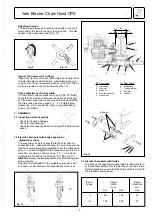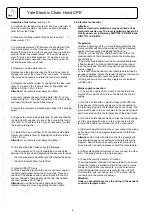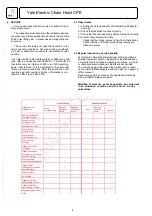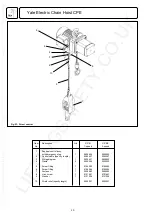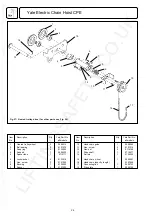
11
ball bearing (36). Remove snap ring (34) and press
ball bearing (36) out of bearing plate (33). Remoove
snap ring (37) from gear shaft (35).
washers (30) as well as planet gear carrier assy (27)
and pinion (26). Pull out gear shaft (35).
10. Remove threaded pin (17).
11. Press out remaining gears in the housing (1) in
direction of the flange. Light blows with a rubber
hammer in axial direction onto the rim of the housing
(flange side) may be helpful to loosen the bearing race
12. Remove planet gears (25), needle bearings (24) and
stop washers (23) from planet gear carrier (22).
13. Pull planet gear carrier (22) and pinion (21) out of planet
14. Remove ball bearing (20) and bearing race (15) from
15. Remove snap ring (11) from planet gear carrier (3) and
press out planet gear shaft (10).
16. Remove planet gears (7), needle bearings (8), stop
washers (6) and spacer rings (9).
15. Remove bearing (5) and packing rings (4).
After cleaning, inspection and replacement of all worn parts
re-assembly can be started.
Parts subject to wear are: stop washers (6, 23, 30), needle
bearings (8, 24, 31), O-rings and packing rings (4, 16, 18,
Reassemble the gearbox in the reverse order strictly in
accordance with the sectional drawing.
Special care should be taken for clean and correct instal-
lation of planet gears (7) with needle bearings (8) in equal
sorting and stop washers (6) as well as spacer rings (9) in
The friction discs (28) on either side of the ring gear (29)
must be installed oil-soaked (leave in oil for 1 hour before
The exact adjustment of the overload device is only
possible when the hoist is completely reassembled. Pre-
adjustment of the cup spring (41) is made with the fixing
After the exact adjustment has been made, the fixing screw
(42) is secured by means of the ball (46) and the threaded
Under normal conditions the motor is practically main-
tenance-free. Every 2.1/2 years the bearings are to be
inspected, cleaned and repacked half-full with grease. We
recommend K 3 N / KL 3 N DIN 51825 / DIN 51502.
Service to the disc brake is reduced to checking and adjust-
ing the brake air gap. The disc brake air gap should be
between 0,2 and 0,6 mm (this guarantees a short reaction
time and low noise emission). When the wear and tear of
the brake lining comes down to the point where the max.
possible air gap has finally been reached, it is indispen-
sible to carry out a re-adjustment of the brake (the max.
permissible air gaps are shown in the table below).
armature disc B42 und adhesive plate B16 (thickness
of the spacer blocks is to be found in the table below).
3.4 Tighten screws B31, or - in case of two shaft extensions
- nut B35 to an extent as to permit the removal of the
3.5 Evenly tighten the binding screws B14. Please tighten
first screw placed opposite of the fitting key (for the
permissible torque consult the table below).
Attention: Do not allow the brake friction pads to come
into contact with lubricant or similar.





